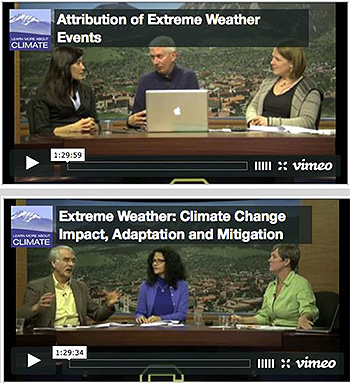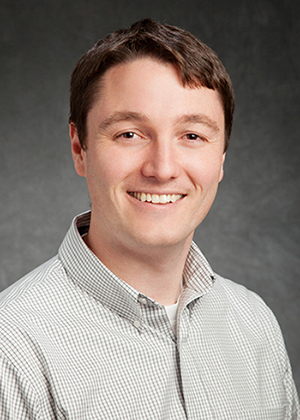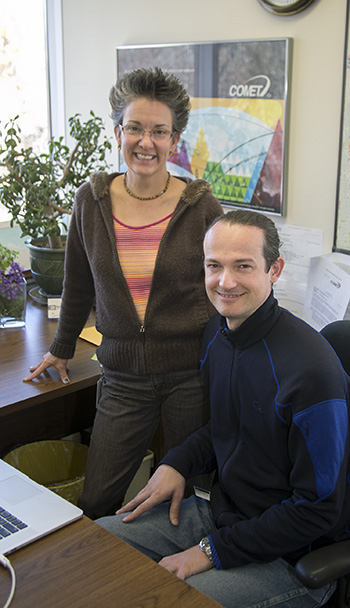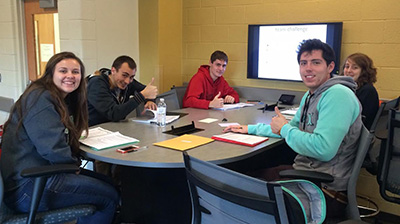Flipping the classroom paradigm
Faculty explore new modes for teaching weather and climate
Nov 14, 2014 - by Staff
Nov 14, 2014 - by Staff
November 18, 2014 | The urge to transform higher education through online technology is making its way into atmospheric science. Benefits as well as pitfalls came to light as faculty on the front lines of experimentation shared notes in a UCAR-hosted forum on October 16. The session was part of a two-day meeting of heads and chairs of departments of atmospheric science, an event cosponsored every two years by the American Geophysical Union and the American Meteorological Society.
Part of the push behind the new techniques is to serve broader audiences. This is the prime motivation behind the massively open online courses (MOOCs) that have proliferated in the last three years across a wide a range of disciplines. But faculty are also trying new ways of connecting with in-residence students, as technology opens up possibilities well beyond the traditional stand-and-lecture model.
MOOCs typically allow students to sign up for free without prerequisites, with tens of thousands enrolled in the most popular MOOCs. In some cases, course credit can be earned if extra work is completed and tuition is paid.
One of the key points emerging from research into MOOCs, and noted during the discussion at UCAR, is that technology is no panacea: careful design of meaningful learning interactions that take advantage of technology is still crucial for success. After an initial burst of interest and publicity, analysts have found that many MOOCs generate huge dropout rates and sometimes-mediocre learning outcomes. As noted in the New Media Consortium’s 2013 Horizon Report on higher education (PDF), some observers believe that the rapid growth of MOOCs has made it difficult to carefully analyze their impact and develop best practices.

Clips from moderated panel discussions were a key part of the MOOC on climate science organized last summer by the Cooperative Institute for Research in Environmental Sciences. The 3- to 5-minute video clips originated from live webinars that included a chat function for viewer questions. (Image courtesy Anne Gold, CIRES.)
“Time will settle those questions,” notes the report, “but there is no doubt that MOOCs have already had a significant influence on the future course of online learning, and deserve close attention, study, and continued experimentation.”
Anne Gold (Cooperative Institute for Research in Environmental Sciences, or CIRES) led a prototype team-based MOOC this summer, Climate Science Connections: Water in the West. The course drew an international group of more than 500 participants, said Gold, who’s also experimenting with other techniques to bring climate science to groups of varying sizes using a mix of technologies.
“The variety of people who participate in a MOOC is incredible—it makes it very interesting to teach in this format,” said Gold. “We had teachers, graduate students, professionals, interested public, water lawyers, policy makers, politicians, and fishermen, among others.”
A few atmospheric science departments have dipped toes into the MOOC water, mainly in the realm of climate. Coursera, one of the leading MOOC companies, includes several courses related to climate and Earth-system processes in its catalog. Among the atmospheric scientists involved are David Archer (University of Chicago), David Karoly (University of Melbourne), Veerabhadran Ramanathan and Richard Somerville (Scripps Institution of Oceanography), and David Schultz (University of Manchester). The CIRES course above will move to Coursera next spring.
For faculty who might be toying with the idea of creating a MOOC, Schultz advises that it’s no cake walk. “I did not appreciate how time-consuming it was to build a MOOC,” he said. “I thought I’d throw my lecture material on camera and that would be it.” Smoothing the way was support from his university, including funding specifically for the MOOC that allowed creation of a virtual field trip via Google Earth. “It allowed us to take students to places in the world that support the concepts discussed in lecture,” said Schultz.
Given the questions that global climate raises on environmental, societal, and political fronts, the topic seems ripe to draw the large enrollments expected in MOOCs. In contrast, Coursera doesn’t currently have a single MOOC on introductory meteorology, much less higher-level topics. (As one of the forum attendees put it, “I don’t see how you take a thermodynamics class and make a MOOC out of it.”)

Eric Snodgrass (University of Illinois at Urbana-Champaign) is developing an online MOOC covering severe and hazardous weather. (Photo courtesy UIUC.)
Meteorology’s first major MOOC could be the one now being developed by Eric Snodgrass, who directs undergraduate studies in atmospheric science at the University of Illinois in Urbana-Champaign. He created an online version of the department’s longtime course in severe and hazardous weather; it was named the nation’s best online course of 2012 by the University Professional Continuing Education Association.
Snodgrass is now working on visualizations and short video-driven lectures for a Coursera version of the online class, with an anticipated debut date of fall 2015. There’ll be plenty of high-interest material, including El Niño, tropical cyclones, blizzards, droughts, floods, and tornadoes. The course will train students of all ages to use radar and satellite imagery and computer model output to both observe and forecast extreme weather. “My goal is not only increased awareness and understanding of severe weather, but also a new or renewed passion for studying our amazing atmosphere,” said Snodgrass.
Attracting the bulk of interest and discussion at the Boulder forum was the notion of “flipping” atmospheric science courses, an approach that’s gaining currency across large swaths of academia. In a flipped course, lectures are consumed by students outside of class through videos that can be stopped and started as needed; the classroom itself is devoted to discussion and problem-solving, with faculty on hand to help. Online assessments ensure that students have absorbed the video content before they come into the classroom.
Flipping appears to hit a sweet spot, as it takes advantage of the ubiquity of video on tablets and smartphones while retaining manageably sized classes and in-person elements. A flipped class also gives professors a chance to work more closely, and more often, with students.
“When you think about flipping, you really need to think about it as a course redesign,” said Kevin Perry (University of Utah). In order to carry this out, Perry and others stressed the need for faculty to consult university offices that are dedicated to online instruction. Drawing on research-honed strategies, these are often the best experts on campus in how to create a flipped class.

Wendy Abshire and Tsvet Ross-Lazarov (UCAR's COMET Program) shared their perspectives on online learning practices with university department heads at an October 16 forum hosted by UCAR. (©UCAR. Photo by Bob Henson.)
Several meteorology courses have been taught in flipped fashion over the last few years at the University of Oklahoma, including experimental usage of an active learning classroom, said OU’s David Parsons. “The most successful flipped courses seem to be in the area of programming, where instructor-created materials can supplement high-quality tutorials already available online,” Parsons added.
Nolan Atkins discussed several meteorology classes being flipped for the first time this fall at Lyndon State University, including remote sensing, dynamics, and physical meteorology.
“Student reaction before the implementation was mixed,” said Atkins. A few weeks into the process, though, many students have come around, and Atkins is feeling encouraged. He noted that flipping a course requires student buy-in, high-quality video, and hard work from faculty. The potential gains include more in-depth coverage of the course content and increased student mastery.
“We’re moving away from a ‘sage on stage’ to a ‘guide by the side’,” noted Tsvet Ross-Lazarov, an instructional designer with UCAR’s COMET Program, who joined COMET senior manager Wendy Abshire at the forum. This autumn the program is testing a unique blend of in-person and online lectures, videos, animations, and student-run weather briefings, as COMET staff member Andrea Smith teaches Millersville University’s synoptic meteorology course through UCAR’s UVISIT program. Results will be presented in January at the annual meeting of the American Meteorological Society.
Daria Kluver, an assistant professor at Central Michigan University, teaches a flipped course on climate change. Key elements include the Blackboard learning management system, where lectures notes, assignments, and classroom work are posted, as well as a classroom tailor-made for interaction, where students can bring graphics for in-class analysis and interpretation. Web materials are also crucial for Keah Schuenemann (Metropolitan State University of Denver), whose students each analyze and write blog posts on the impacts that climate change is expected to bring to a particular nation.

At Central Michigan University, students in Daria Kluver's "flipped" course on climate change take in video lectures on their own time and then meet to discuss course material in a high-tech classroom. (Photo courtesy Daria Kluver.)
Kluver stresses the usefulness of CMU’s center for teaching, where she gained relevant expertise in both pedagogy and technology. She finds that a technology-rich workspace is vital in order to get the most out of flipped teaching, especially when you consider the background of today’s college-age student.
“They’re millennials. They’ve spent their whole lives with gadgets in their hands.”
Flipping actually emerged from K-12 education (or “the swamp of practice,” as COMET’s Ross-Lazarov puts it, as opposed to the ivory tower of academia). The first well-documented flipped class took place in 2007 at Woodland Park High School near Colorado Springs.
Does flipping make a difference? “The results from the K-12 world have been very encouraging,” says Ross-Lazarov. A report produced by Pearson, George Mason University, and the Flipped Learning Network includes several case studies hinting at increased engagement and higher test scores. However, the report acknowledges the dearth of rigorous, empirical research to date on flipped-learning outcomes. As for higher education, studies to date suggest that flipping might be best suited to smaller upper-level courses, where motivation and interest is high.
“It seems that in introductory level courses, or in courses where there is little instructional need to flip the classroom, there were no significant differences between the mean test scores of students in flipped versus nonflipped classes,” said Ross-Lazarov. Given the right setting and the right material, he added, “flipping is an exciting development—it offers a lot of potential.”
Session 3: Best practices for balancing lecture-based, online content, flipped, online, and massive open online courses (pages 65–108). Download the PDF (large file, 13 MB)
Writer/contact:
Bob Henson, NCAR/UCAR Communications